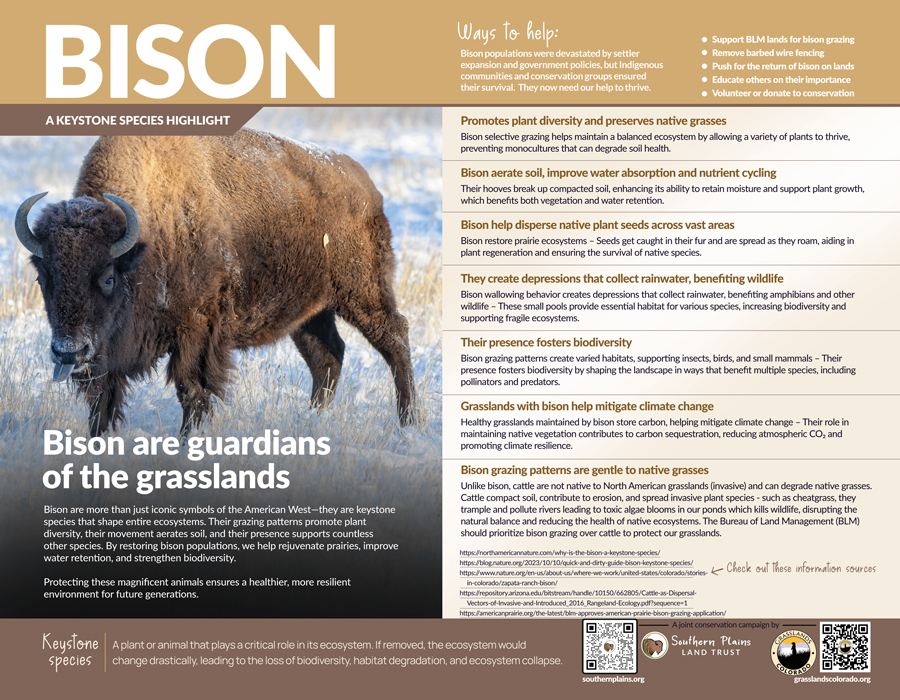
Bison are guardians of the grasslands
Bison are more than just iconic symbols of the American West—they are keystone species that shape entire ecosystems. Their grazing patterns promote plant diversity, their movement aerates soil, and their presence supports countless other species. By restoring bison populations, we help rejuvenate prairies, improve water retention, and strengthen biodiversity.
Protecting these magnificent animals ensures a healthier, more resilient environment for future generations.
Promotes plant diversity and preserves native grasses
Bison selective grazing helps maintain a balanced ecosystem by allowing a variety of plants to thrive, preventing monocultures that can degrade soil health.
Bison aerate soil, improve water absorption and nutrient cycling
Their hooves break up compacted soil, enhancing its ability to retain moisture and support plant growth, which benefits both vegetation and water retention.
Bison help disperse native plant seeds across vast areas
Bison restore prairie ecosystems – Seeds get caught in their fur and are spread as they roam, aiding in plant regeneration and ensuring the survival of native species.
They create depressions that collect rainwater, benefiting wildlife
Bison wallowing behavior creates depressions that collect rainwater, benefiting amphibians and other wildlife – These small pools provide essential habitat for various species, increasing biodiversity and supporting fragile ecosystems.
Their presence fosters biodiversity
Bison grazing patterns create varied habitats, supporting insects, birds, and small mammals – Their presence fosters biodiversity by shaping the landscape in ways that benefit multiple species, including pollinators and predators.
Grasslands with bison help mitigate climate change
Healthy grasslands maintained by bison store carbon, helping mitigate climate change – Their role in maintaining native vegetation contributes to carbon sequestration, reducing atmospheric CO₂ and promoting climate resilience.
Bison grazing patterns are gentle to native grasses
Unlike bison, cattle are not native to North American grasslands (invasive) and can degrade native grasses. Cattle compact soil, contribute to erosion, and spread invasive plant species - such as cheatgrass, they trample and pollute rivers leading to toxic algae blooms in our ponds which kills wildlife, disrupting the natural balance and reducing the health of native ecosystems. The Bureau of Land Management (BLM) should prioritize bison grazing over cattle to protect our grasslands.
Ways to help:
Bison populations were devastated by settler expansion and government policies, but Indigenous communities and conservation groups ensured their survival. They now need our help to thrive.
- Support BLM lands for bison grazing
- Remove barbed wire fencing
- Push for the return of bison on lands
- Educate others on their importance
- Volunteer or donate to conservation
Check out these information sources:
https://northamericannature.com/why-is-the-bison-a-keystone-species/
https://blog.nature.org/2023/10/10/quick-and-dirty-guide-bison-keystone-species/
https://americanprairie.org/the-latest/blm-approves-american-prairie-bison-grazing-application/
Keywords to use in Social posts:
#ColoradoWildlife #GrasslandsColorado #SouthernPlainsLandTrust #KeystoneSpecies #BringBackBison #NativeGrazers #GrazingforConservation #ColoradoBison #HoovesforHabitat #NoMoreBarbedWire #RewildtheWest #Biodiversity #NativeHabitat